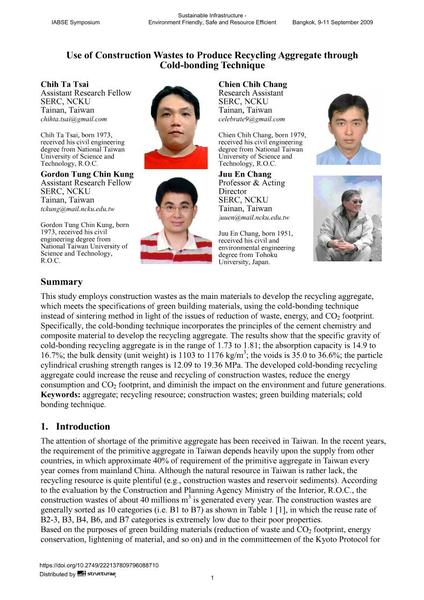Use of Construction Wastes to Produce Recycling Aggregate through Cold-bonding Technique

|
|
|||||||||||
Bibliographic Details
| Author(s): |
Chih Ta Tsai
Chien Chih Chang Gordon Tung Chin Kung Juu En Chang |
||||
|---|---|---|---|---|---|
| Medium: | conference paper | ||||
| Language(s): | English | ||||
| Conference: | IABSE Symposium: Sustainable Infrastructure - Environment Friendly, Safe and Resource Efficient, Bangkok, Thailand, 9-11 September 2009 | ||||
| Published in: | IABSE Symposium Bangkok 2009 | ||||
|
|||||
| Page(s): | 178-186 | ||||
| Total no. of pages: | 7 | ||||
| Year: | 2009 | ||||
| DOI: | 10.2749/222137809796088710 | ||||
| Abstract: |
This study employs construction wastes as the main materials to develop the recycling aggregate, which meets the specifications of green building materials, using the cold-bonding technique instead of sintering method in light of the issues of reduction of waste, energy, and CO2 footprint. Specifically, the cold-bonding technique incorporates the principles of the cement chemistry and composite material to develop the recycling aggregate. The results show that the specific gravity of cold-bonding recycling aggregate is in the range of 1.73 to 1.81; the absorption capacity is 14.9 to 16.7%; the bulk density (unit weight) is 1103 to 1176 kg/m³; the voids is 35.0 to 36.6%; the particle cylindrical crushing strength ranges is 12.09 to 19.36 MPa. The developed cold-bonding recycling aggregate could increase the reuse and recycling of construction wastes, reduce the energy |
||||
| Keywords: |
consumption and CO2 footprint recycling resource construction wastes green building materials cold bonding technique aggregate
|
||||
